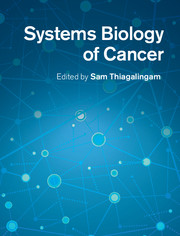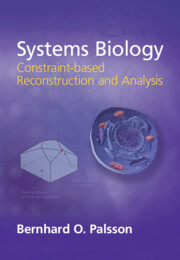Refine listing
Actions for selected content:
1413 results in Ebooks in network science
Chapter 15 - The Wnt signaling network in cancer
- from Part 4 - Functional networks of events that modulate phenotypic manifestation of cancer
-
-
- Book:
- Systems Biology of Cancer
- Published online:
- 05 April 2015
- Print publication:
- 09 April 2015, pp 222-255
-
- Chapter
- Export citation
Chapter 27 - Deregulated signaling networks in lung cancer
- from Part 5 - Current state of the evolving MMMN cancer progression models of cancer
-
-
- Book:
- Systems Biology of Cancer
- Published online:
- 05 April 2015
- Print publication:
- 09 April 2015, pp 421-442
-
- Chapter
- Export citation
Chapter 13 - PI3K pathway in cancer
- from Part 4 - Functional networks of events that modulate phenotypic manifestation of cancer
-
-
- Book:
- Systems Biology of Cancer
- Published online:
- 05 April 2015
- Print publication:
- 09 April 2015, pp 193-203
-
- Chapter
- Export citation
Chapter 30 - Systems biology in cancer biomarkers for early detection, diagnosis, and prognosis
- from Part 6 - Applications of comprehensive cancer progression models in the fight against cancer
-
-
- Book:
- Systems Biology of Cancer
- Published online:
- 05 April 2015
- Print publication:
- 09 April 2015, pp 464-472
-
- Chapter
- Export citation
Chapter 10 - Dietary and environmental influences on the genomic and epigenomic codes in cancer
- from Part 3 - Events responsible for aberrant genetic and epigenetic codes in cancer
-
-
- Book:
- Systems Biology of Cancer
- Published online:
- 05 April 2015
- Print publication:
- 09 April 2015, pp 154-168
-
- Chapter
- Export citation
Chapter 32 - Cancer pharmacogenomics: challenges, promises, and its application to cancer drug discovery
- from Part 6 - Applications of comprehensive cancer progression models in the fight against cancer
-
-
- Book:
- Systems Biology of Cancer
- Published online:
- 05 April 2015
- Print publication:
- 09 April 2015, pp 499-517
-
- Chapter
- Export citation
Part 3 - Events responsible for aberrant genetic and epigenetic codes in cancer
-
- Book:
- Systems Biology of Cancer
- Published online:
- 05 April 2015
- Print publication:
- 09 April 2015, pp 93-168
-
- Chapter
- Export citation
Chapter 9 - MicroRNA epigenetic systems and cancer
- from Part 3 - Events responsible for aberrant genetic and epigenetic codes in cancer
-
-
- Book:
- Systems Biology of Cancer
- Published online:
- 05 April 2015
- Print publication:
- 09 April 2015, pp 134-153
-
- Chapter
- Export citation
Part 5 - Current state of the evolving MMMN cancer progression models of cancer
-
- Book:
- Systems Biology of Cancer
- Published online:
- 05 April 2015
- Print publication:
- 09 April 2015, pp 323-456
-
- Chapter
- Export citation
Chapter 19 - Cancer metabolism
- from Part 4 - Functional networks of events that modulate phenotypic manifestation of cancer
-
-
- Book:
- Systems Biology of Cancer
- Published online:
- 05 April 2015
- Print publication:
- 09 April 2015, pp 295-308
-
- Chapter
- Export citation
Part 4 - Functional networks of events that modulate phenotypic manifestation of cancer
-
- Book:
- Systems Biology of Cancer
- Published online:
- 05 April 2015
- Print publication:
- 09 April 2015, pp 169-322
-
- Chapter
- Export citation
Preface
-
- Book:
- Systems Biology of Cancer
- Published online:
- 05 April 2015
- Print publication:
- 09 April 2015, pp xv-xvi
-
- Chapter
- Export citation
Chapter 28 - Modular signaling in hematopoietic malignancies
- from Part 5 - Current state of the evolving MMMN cancer progression models of cancer
-
-
- Book:
- Systems Biology of Cancer
- Published online:
- 05 April 2015
- Print publication:
- 09 April 2015, pp 443-456
-
- Chapter
- Export citation
Part 2 - Alterations in the regulatory networks of cellular and molecular events
-
- Book:
- Systems Biology of Cancer
- Published online:
- 05 April 2015
- Print publication:
- 09 April 2015, pp 35-92
-
- Chapter
- Export citation
Chapter 1 - Systems biology of cancer progression
- from Part 1 - Introduction to modular organization of the networks of gene functions and cancer
-
-
- Book:
- Systems Biology of Cancer
- Published online:
- 05 April 2015
- Print publication:
- 09 April 2015, pp 1-6
-
- Chapter
- Export citation

Systems Biology of Cancer
-
- Published online:
- 05 April 2015
- Print publication:
- 09 April 2015

Systems Biology
- Constraint-based Reconstruction and Analysis
-
- Published online:
- 05 February 2015
- Print publication:
- 26 January 2015
9 - The Stoichiometric Matrix
- from II - Mathematical Properties of Reconstructed Networks
-
- Book:
- Systems Biology
- Published online:
- 05 February 2015
- Print publication:
- 26 January 2015, pp 151-171
-
- Chapter
- Export citation
18 - Optimization
- from III - Determining the Phenotypic Potential of Reconstructed Networks
-
- Book:
- Systems Biology
- Published online:
- 05 February 2015
- Print publication:
- 26 January 2015, pp 298-311
-
- Chapter
- Export citation
II - Mathematical Properties of Reconstructed Networks
-
- Book:
- Systems Biology
- Published online:
- 05 February 2015
- Print publication:
- 26 January 2015, pp 149-150
-
- Chapter
- Export citation
